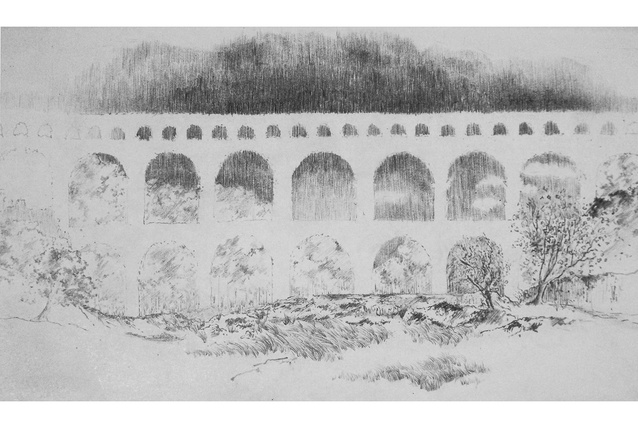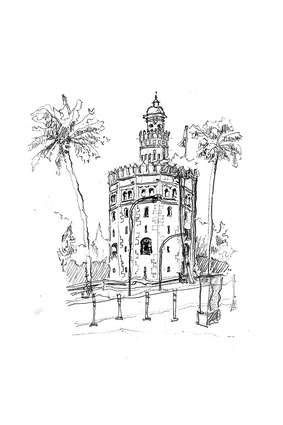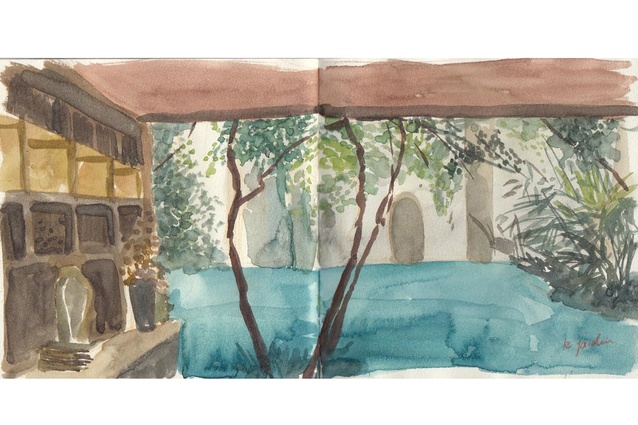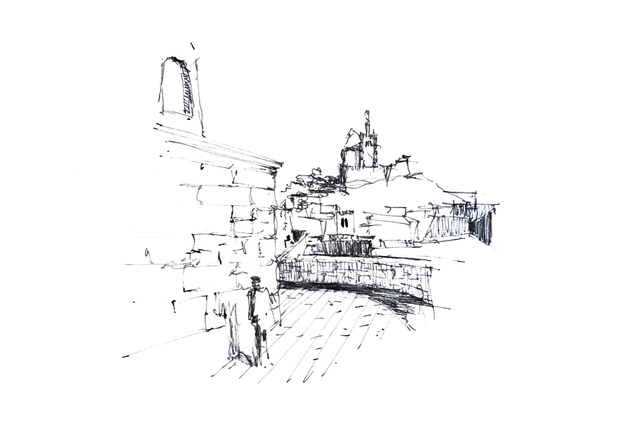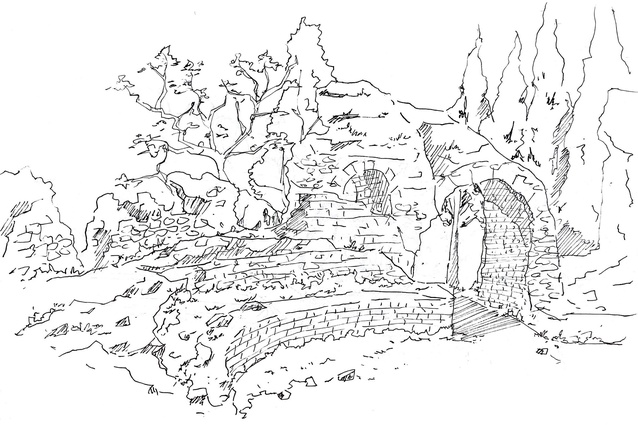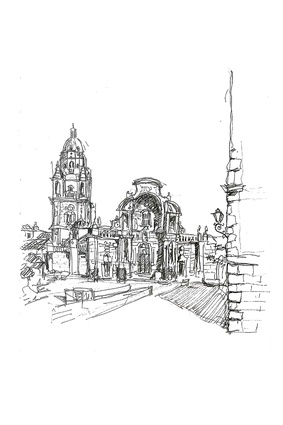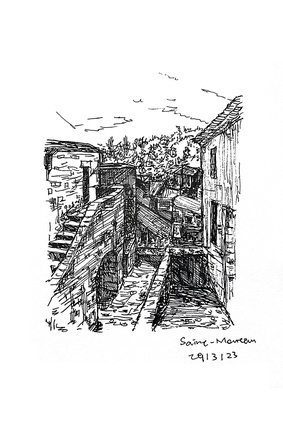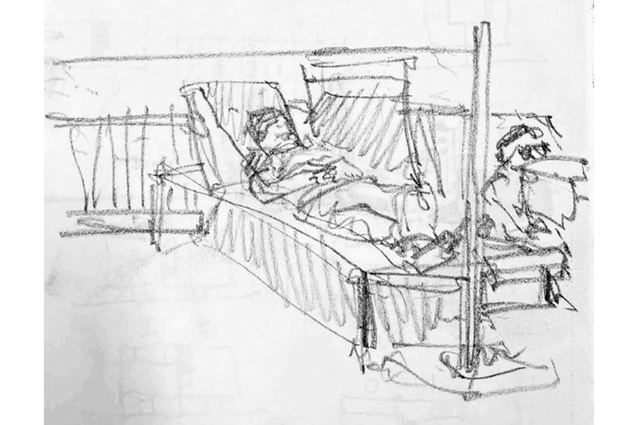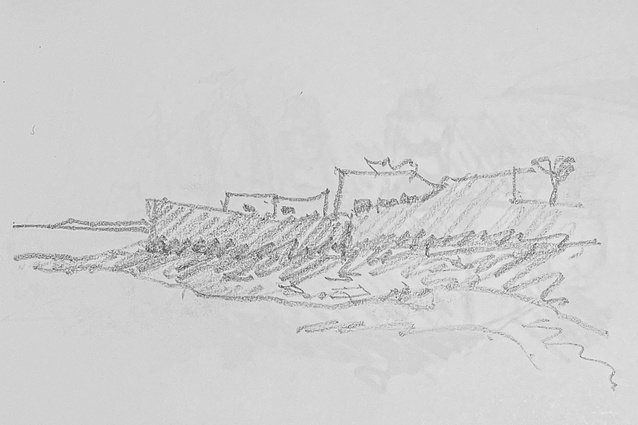Plural, meaning, motion: A meditation on landscapes
MArch(Prof)HerCons student Donna Luo looks back on the University of Auckland’s 2023 Te Pare School of Architecture and Planning study tour through France, Spain and Morocco, and considers our responsibilities with regard to the land on which we live.
It has been a year since a group of students and staff members from the University of Auckland returned from touring France, Spain, and Morocco. Having been raised by black sand beaches and kamahi forests, perhaps it is unsurprising that with a year’s distance to reflect, I think study tours are so precious and enduring because they are meditations on landscapes. We were guided by bodies of water — following the course of the Rhône River, the edge of the Mediterranean coast, and across the Strait of Gibraltar — and along the way encountered the varied and complex ways landscapes exist, their meaning, and relationship to architecture.
Plural (places)
Pont du Gard
When reflecting on landscapes and the places we visited, I often think of Pont du Gard. It is a Roman aqueduct bridge crossing the Gardon River in France, an impossible bridge responsible for carrying water kilometres at length to the Roman settlement, Nemausus (Nîmes).[1] It is a three-tiered structure composed of a series of arches, and despite its restrained appearance it is an otherworldly experience. Sun, wind, and water assert themselves here, and the immenseness of the landscape is equalled by the scale of the monument: fifty thousand tonnes of limestone, stretching from one valley wall to the other.
Unsurprisingly, when drawing, I found myself fixating on the qualities of the landscape in relation to the frame of the structure and the proportions of its arches. ‘Man-made’ and ‘natural’ environments converge here and in doing so make legible the space of a landscape. A valley becomes a room, a river a path. A carpet of grass, bending and swaying — animated by wind and light. There is power here, the surreal and super-real coalescing.
Alhambra
From France, we travelled to Spain, where we visited the Alhambra, an Islamic palatine complex constructed during the Nasrid dynasty. Within the complex lies the Generalife palace, built in the 13th century as a retreat from official business.[2] There is an abundance of spaces that delight your senses, still, it was the Jardines Bajos (lower garden) that I was most enchanted by. It is a series of labyrinth-like spaces consisting of fountains and pools, rose gardens and cypress hedges.
Interestingly, in comparison to landscapes, gardens are defined by their walls. They are the very structures that shun out the wilderness while safeguarding the nature we choose to protect within. Strangely, in the case of the Jardines Bajos, the garden walls are made from living trees that are meticulously pruned to form archways and rooms. These cypress walls, in combination with views of the distant landscape hold an earthly dialogue between the nature within and the landscape beyond.
Seville
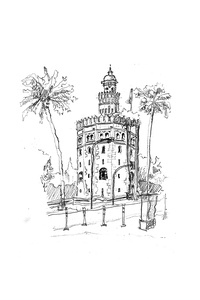
Much of our time in Spain was spent in Seville, kindly hosted by the Escuela Técnica Superior de Arquitectura de Sevilla. For fourth-year students at the time, including myself, this involved a design studio centred on a mixed-use museum typology adjoining a fragment of Seville’s historic city wall. When considering the remaining rammed-earth wall in a city built from Roman, Islamic and Christian architecture, we learnt about the significance of soil not only as physical matter but as an archive of past territories and forgotten landscapes, integral to the city’s identity. Attending studios at ETSA prompted questions on what it means to occupy a land and live with its various and often conflicting cultural and historical layers, a question we continued to consider in regard to our own relationship with Aotearoa.
While the answer will never be simple regardless of where you are in the world, perhaps the there are hints that can be found through walking the city. On any ordinary afternoon in Seville, like much of Europe, you encounter craftsmen casually tending to and caring for the heritage of their hometown. Conservation belongs to the everyday, naturally occupying a place in the hearts and minds of residents, where a regular Thursday afternoon is as good of a day as any to repair the city’s historic walls. Maybe inhabiting a place means a commitment to care — “deeply rooted in the soil of the everyday.”[3]
Morocco
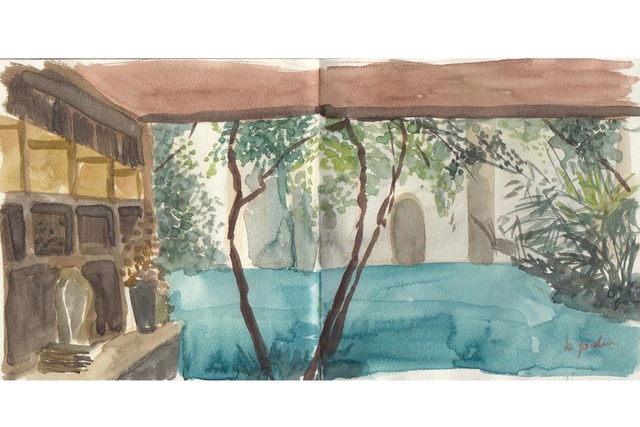
While in France and Spain, we experienced the openness of landscapes designed for whole settlements; in Morocco, they are imagined at the scale of the individual. Landscapes are enclosed, belonging instead to a private, domestic world. The riads we stayed at were characterised by dark interiors arranged around a central courtyard where the rooms could be likened to thickened garden walls. The vastness of a landscape is held unexpectedly within the architecture. They are miniature worlds within worlds with eaves marking out each household’s private allotment of the sky. And almost always, there is water at the centre of each courtyard – a singular obsession in an arid land.
With the exception of sleeping, our time was spent leisurely under the eaves where there was just enough respite from the heat while remaining outside. This seems to be what good architecture does, proving just enough for people to enjoy the climates they chose to make a home in. Curiously, compared to our fixation on glazing in Aotearoa/New Zealand, in Morocco they do not have windows facing into the courtyards. Instead, there are solid openings, as if to ask that you be in the world, rather than look out at it. Views are uncompromisingly accompanied with sounds, scents, and the heat.
Meaning
We think we know what landscapes are, that they are synonymous with ‘environment’ and ‘nature’, but hours spent in a hurtling body of metal and the familiar becomes unfamiliar once more. Upon seeing the varied and ingenious ways people cut, build and burrow, I became aware that landscapes are as much geographical realities as they are cultural constructs, created from the reciprocity between the will of nature and our collective “imagination projected onto wood and water and rock.”[4] And with every square inch of the earth having been traversed and mapped, landscapes have long ceased to be ‘natural’. They can only exist through our perception and encounters, our making of territory.
In this manner, architecture was never adversarial to landscapes. Modernism’s pursuit of a tabula rasa might have had us fooled, but all buildings are of a place; built from the body of the earth, mountains, and trees. And, like us, they must have a place to rest. The work of architects is indissolubly interlinked with the land, each one making and remaking the other, dutiful to the task of building a good home. Since is that not how it all began? Past civilisations transformed their landscapes, taming the terrors of immeasurable places so, ultimately, they could create a home that would sustain them.
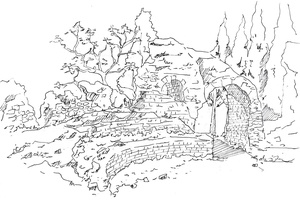
I think back to an interview between Tony Watkins and John Walsh and remember that architecture is as much a practice of ways of loving as it is of living.[5] To build a wall in a boundless landscape is to give meaning to the land and to enter a relationship with a place. It is to say, ‘Ahh yes, here is a good place to build a life, under this sky’. The best buildings are where there is love. They show us how people live with the things they choose to care most for, and because of it, we become ultra-conscious of what is beautiful and irreplicable about a site.
Motion
Each place we visited offered an invitation to look closely, give our full presence, and consider what wisdom we might carry home. For many of us, the possibility was faithfully met through drawing. To draw in-place and in-time is a creative act of fieldwork, both documentation and interpretation of place. More than a process of image production it is a method of understanding through observation; where inhabiting, thinking, and making are inextricably tied to the very material of the place.
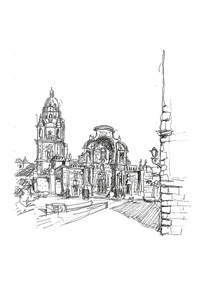
Drawing requires that we participate in the dynamic processes of a site, recording with the entirety of our bodies. In this sense, when drawing in the field, the line of a pencil becomes analogous to the path of our eyes and our bodies in spaces. It is reminiscent of Paul Klee’s description of a line as “a point going for a walk”.[6] Accordingly, the character of the lines revealed the conditions of their making — the instances of hesitation or haste — the body in motion.
Gratefully, many nervous and clumsy students (including myself) were patiently tutored by Jim Ireland on how to attend to the scenes in front of us. On one occasion at the Alcázar, in the Jardín de los Naranjos, he kindly guided a trio of third-year students on how to approach drawing trees architecturally. Drawing faithfully revealed the analogous relationships between architecture and landscapes; making out column and beams from the trunks and branches.
While drawings are durational documents, they are not fixed to a clear start or end. Arguably, drawing as a media practice asks for continual reflection, to be reworked on bus rides, and into university projects long after we had returned home. It seems that landscapes have claimed their stake within our minds, and while we have moved through different places, their authority remains the same.
Meditation
On the flight home, between fits of sleep, I would sit and watch the plane’s webcam. How bizarre to see deserts giving way to water and water to clouds, as if to affirm how powerful and incomprehensible landscapes will always be. It is as Geoff Park said, “landscapes exist. They fascinate and entertain us. They reveal how the past produces the present. They nourish and show us who we are, and who, culturally, we have been.”[7] Despite all that, they are living systems, changing before we can define them as if they are on the tip of the tongue and not the nose.
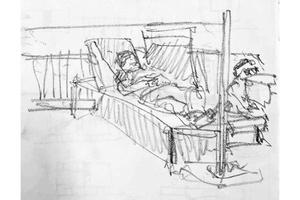
I spent most of my university education determined to get my degree and run off into the world (as every twenty-something-year-old intends to do). But it is strange how time spent away from home reminds you that your heart lives outside your body, in a cluster of islands at the edge of the Pacific Ocean — islands marked by volcanoes, senescent forests, and birdsong — duly dotted with huts and baches. Having been fortunate to have witnessed — in places near and far — how beautiful architecture can be when created with a fierce love and commitment to a place, I am conscious that we have a duty of care.
In creating a building, we must also “repair the world around it, and within it, so that the larger world at that one place becomes more coherent, and more whole”.[8] So, I wonder, what are our responsibilities to our land, and what does it mean to build a good home here? While I know the big, wide world is out there waiting, for now I am sure, there are questions that deserve our attention. Our work is here — and what wonderful work it is.
My warmest thanks to the many hands who worked to build the study tour programme: Michael Milojevic, Robin Byron, Jim Ireland, Mike Davis, Vanessa Ceelen, Cindy Huang, Will Martel and Karena Coetzer.
[1] George F. W. Hauck, “The Roman Aqueduct of Nîmes.” Scientific American 260, no. 3 (1989): 98.
[2] Thomas B. Cole, “Garden of the Generalife in Granada: Théo van Rysselberghe.” JAMA: the journal of the American Medical Association 314, no. 1 (2015): 10.
[3] Gaston Bachelard The Poetics of Space, (Boston: Beacon Press, 1994), xiv.
[4] George F. W. Hauck, “The Roman Aqueduct of Nîmes.” Scientific American 260, no. 3 (1989): 98.
[5] Tony Watkins, “Cultural Icons - Tony Watkins,” interview by John Walsh, Cultural Icons, January 13, 2020, audio, 26:44, https://culturalicons.co.nz/50-tony-watkins/
[6] Paul Klee, Pedagogical Sketchbook, (London, Faber & Faber, 1968), 16.
[7] Geoff Park, Theatre Country: Essays on Landscape and Whenua (Wellington, Victoria University Press, 2006), 197.
[8] Christopher Alexander, Sara Ishikawa, and Murray Silverstein, A Pattern Language: Towns, Buildings, Construction, (New York: Oxford University Press, 1977), xiii.


